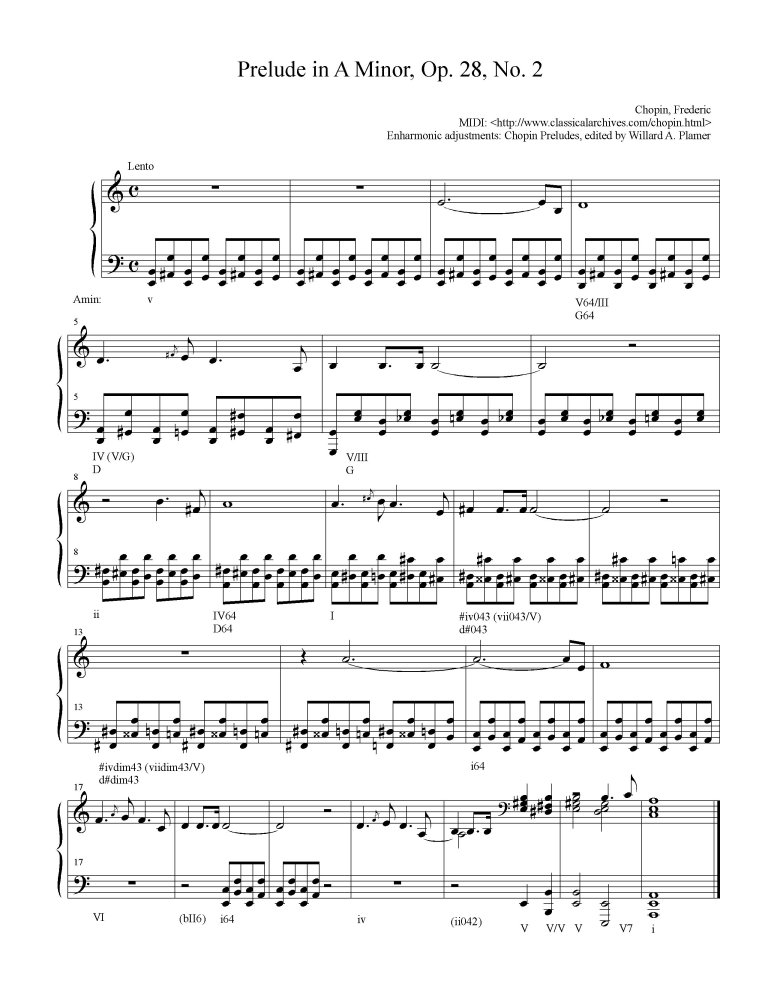21 November 2004
Analysis: Chopin Prelude Op. 28, No. 2
Scott Spiegelberg recently published an analysis of the Chopin Prelude Op. 28 No. 4 and suggested that number 2 was ripe for analysis also. It got my curiosity up, so there goes a few hours of my time ...
This is obviously one of Chopin's [Wikipedia] more dissonant pieces--from the brutish tritones, a listener might think it is a Liszt composition. The difficulty in the analysis was hearing which notes are relevant to the harmony and which are non-harmonic. At a certain point, it becomes more art than science. Where the last chord is indisputably the minor tonic, the role of certain others might be argued. I had a little difficulty with the third phrase, measures 8 through 12, until I actually played it and heard something different from my original analysis. You should always trust your ear.
The left-hand figure, although written as a succession of intervals, should be analysed based on its cross relations. For the first two intervals, we hear the E jump up to the high G and the B jump down to the A# below it. This creates an inner voice with the pattern B-A#-B-G and continues in a similar manner throughout the piece.
.jpg)
The piece is broken up into the following phrases using two key motifs first heard in measures 1-2 (motif A) and measures 3-4 (motif B):
- Measures 1 through 2 (an introductory, harmonic phrase)
- Measures 3 through 7 (A B)
- Measures 8 through 12 (A B)
- Measures 13 through 23 (A B B cadence)
The piece begins with the minor dominant (Emin) in measures 1 through 3 and then tonicizes its relative major (Gmaj) in measures 4 through 7. Measures 8 through 10 are in the parallel major (Amaj). Measures 11 through 14 tonicize the dominant with its diminished vii chords (I've marked diminished chords with a minor 7th as '0' and with a diminished 7th as 'dim'). They resolve to the dominant-tinged minor 64 chord in measure 15. For the un-harmonized melody in measures 17 and 18, I heard an echo of the harmony in measures 5 and 6. Measure 17 is definitely Fmaj, but measure 18's Bbmaj can only be inferred. Motif B is then duplicated and the piece closes with a declarative and simple dominant cadence.
Here is a summary of the harmonic analysis:
- Measures 1 through 3: Emin
- Measures 4 through 7: Gmaj
- Measures 8 through 10: Amaj
- Measures 11 through 14: vii/Emaj
- Measures 15 through 19: Amin64 (with Fmaj-Bbmaj)
- Measures 20 through 23: cadence (Bmin-Emaj-Bmaj-Emaj-Amin)
[ updated 23 Jul 2011 ]
Adding Dies Irae based on Wolfman0's suggestion in comments.

- Opus 28, Number 2 [MIDI]
- Opus 28, Number 2 [Sheet Music]
- The vinyl and the concert posted by sstrader on 21 May 2016 at 1:59:26 PM
- Rod McKuen posted by sstrader on 22 March 2016 at 8:58:35 PM
- More political transcriptions posted by sstrader on 20 March 2016 at 10:19:06 AM
- Notes on We Don't Care About Music Anyway posted by sstrader on 7 June 2015 at 1:06:34 PM
- Ives Concord Sonata posted by sstrader on 13 February 2015 at 5:13:17 PM